Why Do Tomato Plants Turn Yellow? 9 Reasons & Fixes
-
Pete Ortiz
- Last updated:
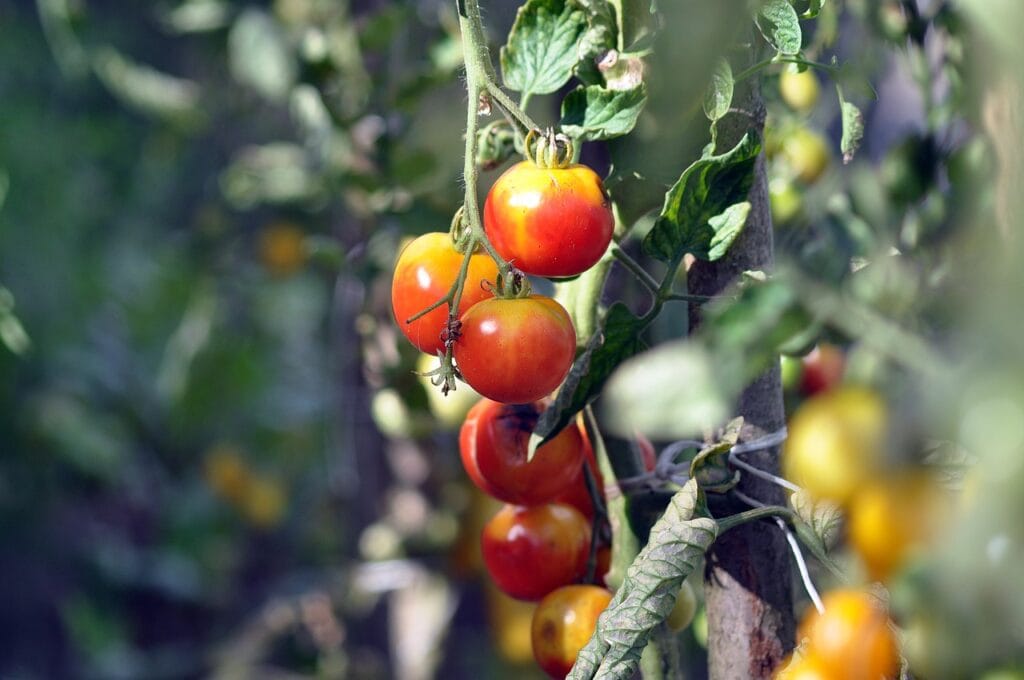
Tomatoes are great plants for your garden. They grow quickly, and when they are happy, they can produce a lot of fruit. There is nothing more discouraging than planting a tomato, getting it to sprout, and then watching as it slowly turns yellow. Tomato plants turn yellow for a variety of reasons. Some of them are natural, and others are very serious. Each reason has its own explanation and solution. With the right information and correct care, you can usually reverse the effects of yellowing in your tomato plants.
Here are the reasons why tomato plants turn yellow and what you can do to fix it.
The 9 Reasons Tomato Plants Turn Yellow
1. Watering Issues
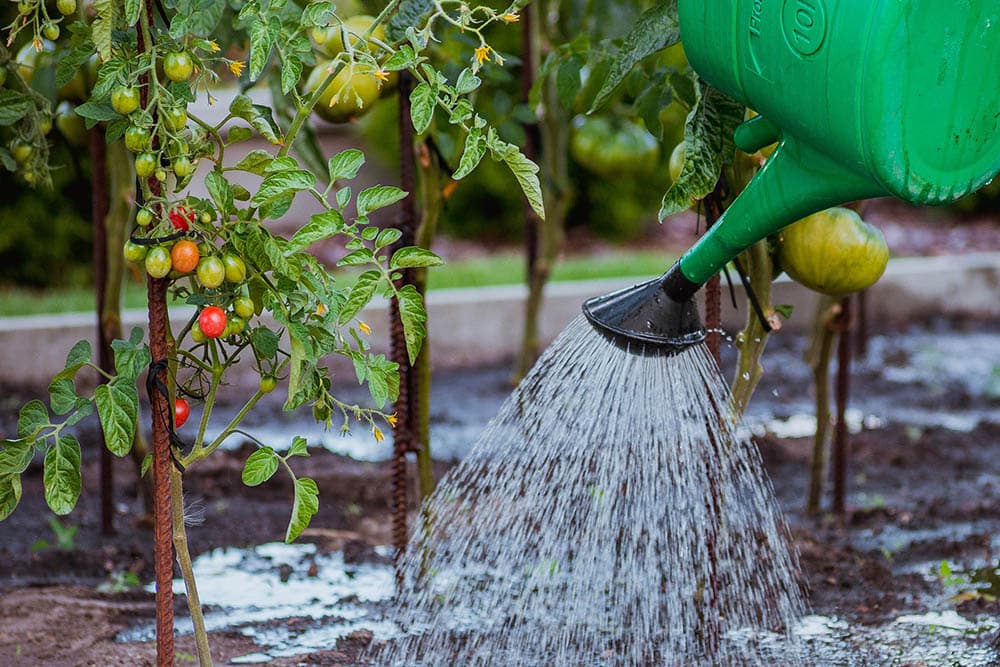
One of the simplest reasons for a tomato plant (or any plant for that matter) to turn yellow is an issue with its water consumption. Water issues are easy to identify and easy to fix. If your tomato plant is turning yellow due to water issues, it should be an easy fix.
The Solution
Change your watering habits. Check to see if the dirt around your plants is dry or caked. Tomato plants have shallow roots and can dry out quickly in hot weather. If you think your tomato plant is dry, water it more frequently. Monitor the plant for a few days after increasing the water to see if the plant starts returning to its natural color.
In some cases, it is possible to overwater your tomato plant. If you give your plant too much water, it can sit in the soil and cause a moist environment that invites rot. When a plant’s roots start to rot, the plant will begin to fade and eventually die. If you believe your plant is waterlogged, cut back on the watering and monitor for progress.
2. Sunscald
Sunscald is similar to sunburn but for plants. Tomato plants are especially susceptible to sunscalds. Sunscalds can turn both the tomato itself and the leaves yellow.
The Solution
Try to get your tomato plant more shade. Tomatoes like direct sunlight, so you don’t want to put them too much in the shade, but if you suspect that your tomato has sunscald, you want to move it out of the most intense rays.
Sunscald happens during the hottest days of the year when a tomato sits and bakes in direct sunlight. Dappled shade or proximity to a building or shed can help get the plant out of the worst of the sunlight. If the plant is removed from the intense sun, the effects of sunscald should start to dissipate.
3. Poor Nutrients
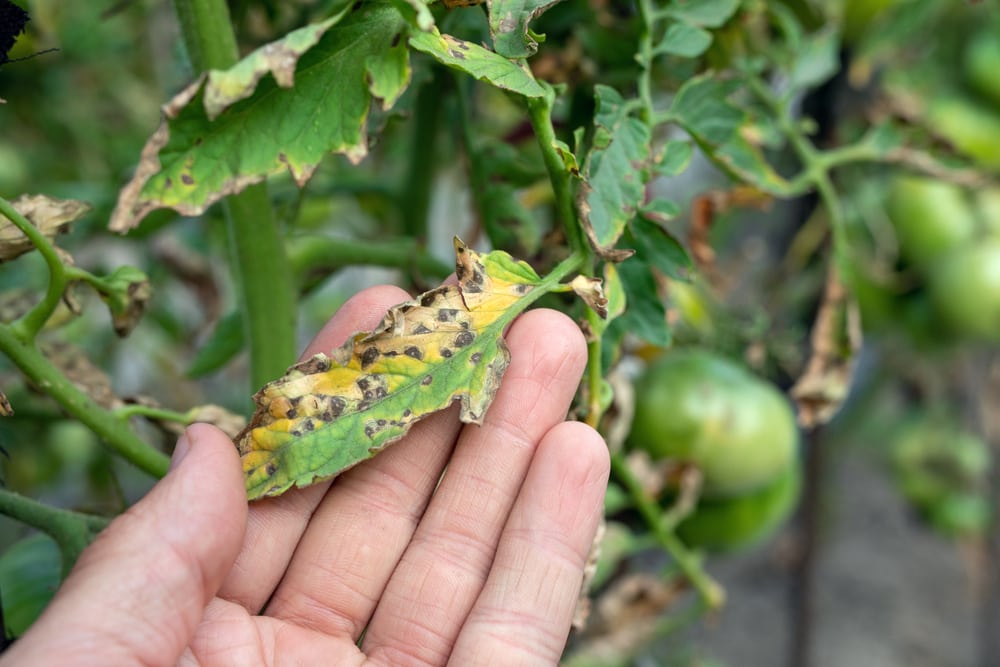
Sometimes the problem with your tomato plant could be hiding in the soil. Poor soil can deprive a plant of key nutrients, which will cause it to fail and turn yellow.
The Solution
The best solution for soil problems is to have your soil tested. Look up where the closest local extension office is and see if they are able to run a soil test for you. Testing your soil provides the best chance of success because you can find out exactly what your soil is lacking.
The only way to provide an effective supplement for the soil is to know what it is deficient in. Soil can lack all sorts of nutrients or be home to damaging microscopic organisms such as nematodes. Once you know what your soil is lacking, you can craft an effective rejuvenation plan to help add back the most important nutrients.
4. Pests
Tomatoes are pest magnets. You are not the only one hoping to chow down on some juicy ripe tomatoes. Tomato plants can suffer from a host of natural pests that can cause them to yellow.
The Solution
Find a pesticide that is designed for use on tomato plants. See if you can identify what type of pest is infecting your plant and choose a pesticide accordingly. Beetles are one of the most common culprits, but aphids and grasshoppers are also common source of tomato plant destruction. If you do not want to use pesticides on your vegetables, you will have to be more creative. You can try and rinse the pests off, plant pest warding plants around your tomatoes or create your own deterrent spray from pepper, salt or onions.
5. Disease
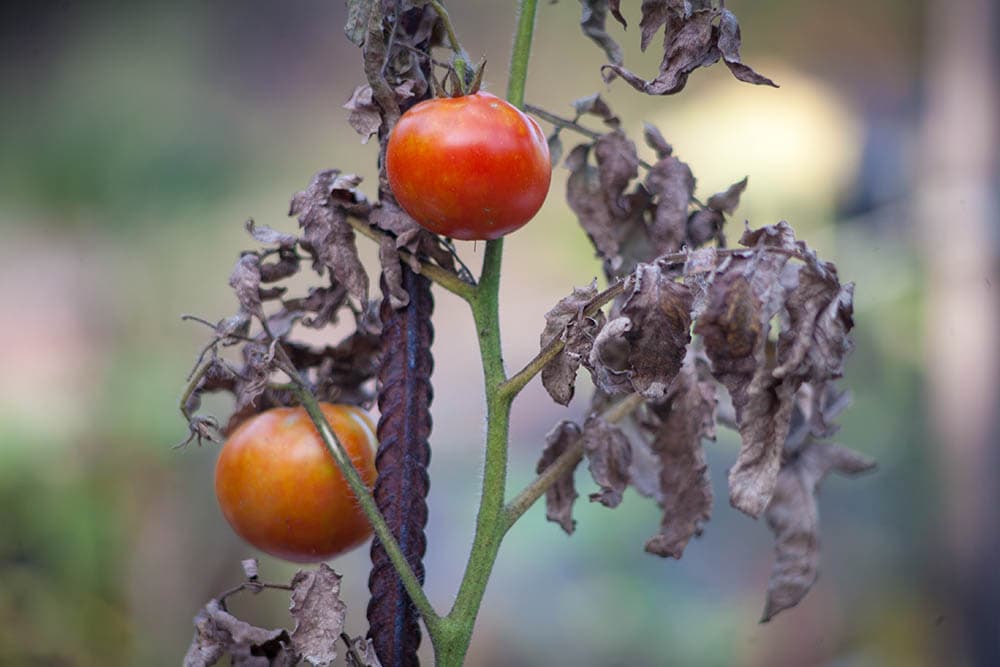
Tomato plants can contract diseases like animals. There are numerous types of diseases that could be affecting your tomato plant, including bacterial infections, viruses, mold, fungal disease, and blight. A diseased tomato plant requires care and attention in order for its condition to improve effectively.
The Solution
The first step to treating your tomato plant is figuring out what kind of disease it may have. The best way to do this is via an extension office. If you do not have a nearby extension office, you can try and match photos and symptoms online. Once you know what kind of disease you are facing, you can find a treatment method.
Mold and fungus are treated with anti-fungal sprays that you can buy at the store. Nematode infection requires treating the soil. Some diseases, such as blight, will require adding lime or potassium to the soil. Some diseases are fatal and will require you to destroy the plants to reduce the spread. It all depends on how advanced the disease is and what type of disease it is.
6. Herbicide Use
Tomato plants are very sensitive to the use of herbicides. If you have been using weed killers near your tomato plants, even on the lawn around your garden box, you could be adversely affecting the health of your plants without even knowing it.
The Solution
Do not use any herbicides near your tomato plants. Weed killers will quickly kill your tomatoes. The best way to keep weeds from your tomato plants is to weed the area by hand. Even a little contamination from an herbicide can cause a tomato plant to die rapidly. If you notice your tomato plant turning yellow after using a weed killer in the garden, this is likely the culprit.
Cease using weed killers immediately, water your tomato plants thoroughly, and monitor them. If the tomato plant got a lethal dose of herbicide, it might be too late to save it, but in many cases, if the contamination was light, the plant will rebound.
7. Soil Compaction
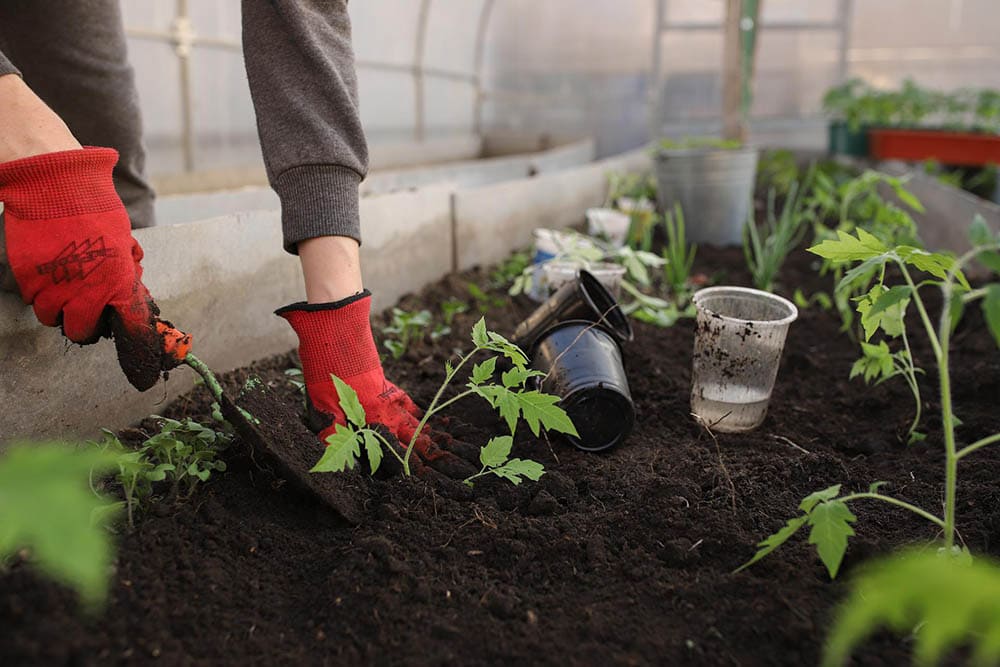
Sometimes the soil around your tomatoes can become too compact, which can harm the plant. Tomatoes like loose well-draining soil and thrive when these conditions are met.
The Solution
Compacted soil can prevent the tomato’s roots from getting the necessary oxygen and water to survive. If the soil is too dense, it can lead to root rot and suffocation of the plant. Luckily, the solution is simply digging up the soil around your tomato plant.
You can use your hands to break up the soil to allow water and air better access. Be careful not to damage the base of the plant or the roots. Till the soil thoroughly around the yellowing plants and then water. Check to make sure the soil is not getting compacted again, and then monitor for results over a few days.
8. Overcrowding
Sometimes a crop of tomato plants will absolutely explode. This could be heartening to see early in the season, but sometimes too much growth by too many plants can be a bad thing. When plants are planted too close together and grow very quickly, it increases the likelihood of problems due to overcrowding.
The Solution
If your tomato plant is surrounded by other plants and is turning yellow, it might be the victim of overcrowding. Culling might be necessary. Choose the healthiest-looking plants and then remove the frailer plants from the area. If you have multiple tomato plants growing in the same area, it might be necessary to remove healthy plants from the vicinity or trim them back, or remove the yellowing plant and plant it in an area by itself.
Make sure the yellowing plant is not obstructed from the sun by nearby plants, increase water, and check to see if the base is being crowded out by other plants. Adjust the spacing and check for progress.
9. The Season Is Over
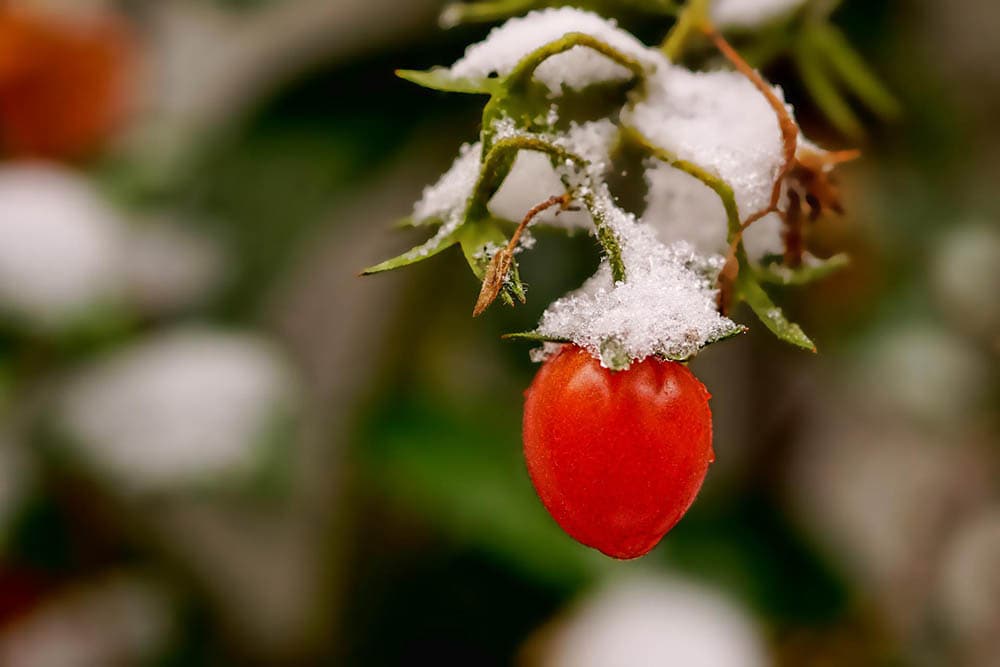
Sometimes your tomato plants are yellowing simply because they are dying naturally. Seasonal plants all reach their inevitable end at some point. It might be your tomato plant’s time to go.
The Solution
Say goodbye. Unfortunately, most tomatoes are grown as annuals meaning they are not meant to survive the winter. If your tomato plants are turning yellow in late summer into fall, it could be that they are simply dying at the end of the season. In warm climates, you can try and nurse your tomato plants through the winter, but they will need to be fertilized and kept warm through frost and freezing.
If you got through a full season of warmth and ripe tomatoes, it is okay to let your tomato plant go and run its natural course. If you enjoyed your tomato garden, start planning for its revival during next year’s season.
In Conclusion
Tomato plants can turn yellow for a variety of reasons. The simplest solutions involve adding more water or nutrients, and other issues can require soil testing and advanced disease control. Tomato plants can yield a lot of great produce, but they can also be very sensitive to sunlight, water, and pests. Identifying the root cause of the yellowing is the first step to finding the best available solution. If caught early enough most tomato plants can be revived and will recover in no time.
Related Read:
- 5 Reasons Why Pepper Plant Leaves Turn Yellow and How to Fix it
- 10 Reasons Why Your Tomato Plants is Not Flowering and How to Fix it
Featured Image Credit: artellliii72, Pixabay
Contents



